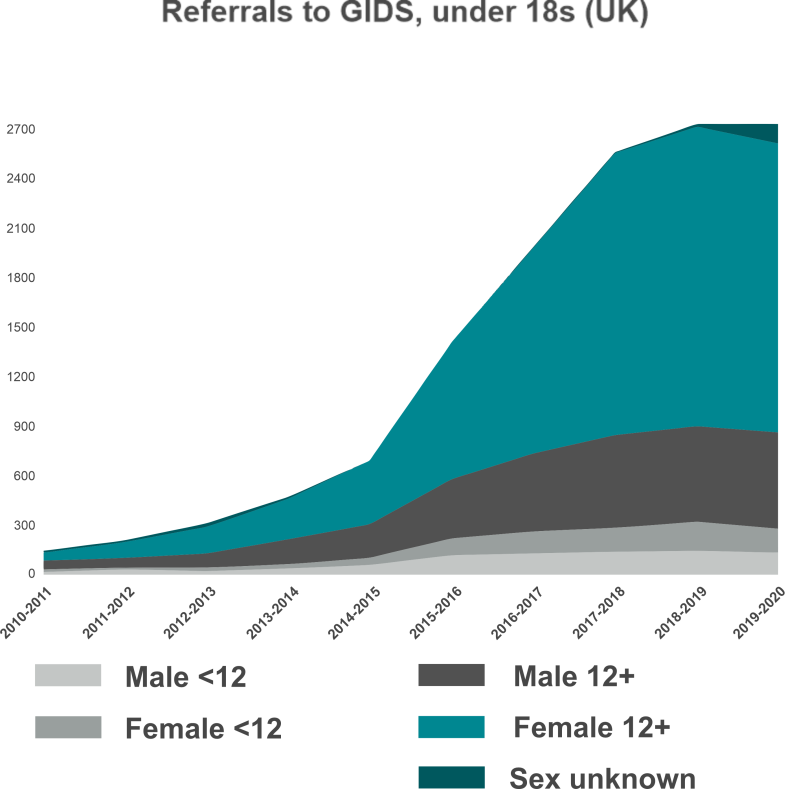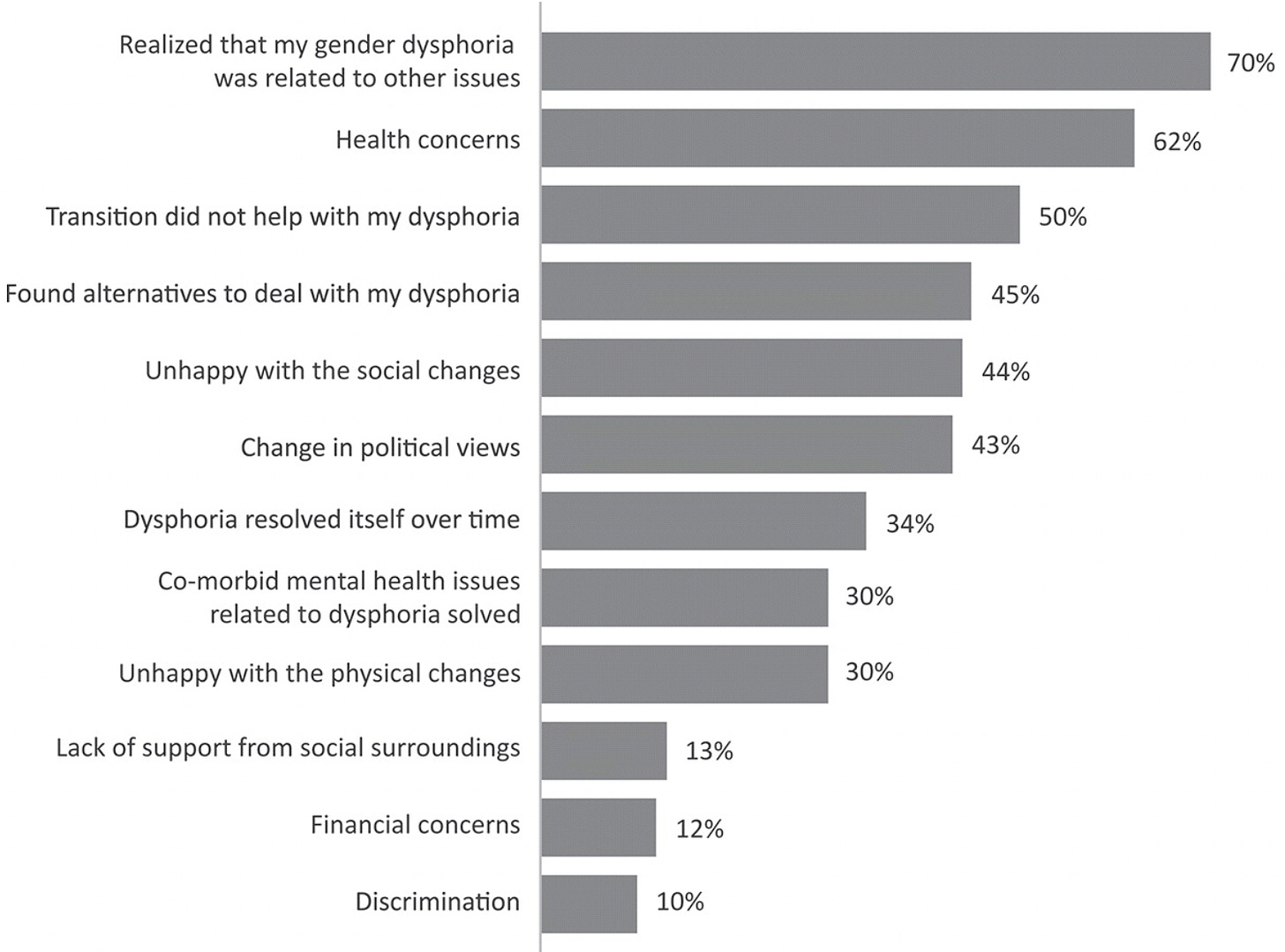Gender dysphoria among adolescent girls
I am a French mother, whose teenage daughter recently announced to me that she was gender dysphoric and wanted hormones. Being left-wing politically oriented, a feminist, and sensitive to the rights of minorities, I first thought my daughter had to be supported in the difficult path to transition. I find this is a common first thought. But after researching the issue, I discovered a completely different—and terrifying indeed—perspective— that my distressed daughter was being rushed down a highly dangerous path. I found also, that, as girls like my daughter hurtle down this road, they are encouraged at all turns by LGBT activists who sincerely believe they are fighting for freedom and against discrimination, while, at the same time, being secretly funded by companies with dubious ethics. This happens in a context where the Media, the educational sphere and the medical world are largely and woefully misinformed, and generally sympathetic to Trans claims of marginalization to the exclusion of all other perspectives.
Great Britain, Sweden and Finland are ahead of France on this path of gender ideology—and in terms of resistance to the trend. For years, in these countries, as well as in North America, parents and health professionals have kept their doubts alive and have challenged the ideology behind medical transition of minors. Today medical studies abound showing the ineptitude and danger of early transitions before age 25.
You may not feel concerned by this story. Maybe you are more interested in classical politics, social inequalities and the climate change. But… the trans wave is now in France, just four or five years after Great Britain, and we need to be vigilant and aware.
Today, it is my daughter. Maybe your daughter will be next? Or her childhood friend? Or the neighbor’s daughter? Your niece? One of your students? One of your patients? Your granddaughter? Your sister or cousin? And this contagion is not limited to girls. Boys too are increasingly under threat from trans ideology.
More than anything else, I researched and wrote this to protect my daughter and help her question this dangerous path before rushing headlong into it. For this reason, I must keep my name secret, and I cannot activate my usual professional, friendly, feminist, political networks.
My hope is that my research, written in French and translated to English, will help others. Most of the resources linked in this article are in French, some in English. This is a world-wide phenomenon and resources should be available, eventually, in all languages.
I thank you for disseminating this text as widely as possible, by all the means at your disposal, including social networks used by young people: Tiktok, Instagram, Facebook, and your friendly, educational, medical, lesbian, feminist, media, political networks… All ideas are welcome to support our girls and boys!
1. What is this about ?
Gender dysphoria is a kind of suffering related to the feeling that one belongs to the other gender, in relation to one’s birth sex. Until recently, this was a rather rare diagnosis. However, in the last decade, this phenomenon has increased exponentially, by + 1500% to + 4000%, especially among young girls in Western countries.

Graph Source: Society for Evidence Based Gender Medicine (SEGM)
The documentaries The Trans Train1 and Dysphoric are excellent resources to discover a phenomenon which has swept through the USA, Canada, Great Britain, Sweden, Finland, and is now arriving in France, Spain and the rest of Europe. The video “Gender or Sex?” (in French) is also very educational and family-friendly.
Some studies suggest a kind of social contagion is going on, a phenomenon related to a form of expression of adolescent suffering in young girls similar to adolescent anorexia. Clusters—groups of young girls wishing to transition—are frequently seen appearing.
2. Sex and gender, vocabulary and ideologies
Gender ideology is rife with new and reinterpreted terms, and it’s important to learn how trans-activists use them in untraditional ways.
The sex of a person is biological data linked to our DNA (XX or XY in 99.8% of cases, intersex in rare cases). This genetic heritage determines (except intersex exceptions, in 1 to 2% of cases) the primary sexual characteristics: ovaries, uterus / penis, testes as well as secondary sexual characteristics, after puberty (chest, hair, etc).
By widely shared convention, we call female a human female (XX) and man a human male (XY). Gender usually refers to the set of socially constructed differences and stereotypes associated, in a given culture, with each biological sex. So, today, pink is said to be the color of girls and blue that of boys, although the opposite convention prevailed in the past.
Thus, from a classical feminist perspective, sex is a physiological datum that cannot be changed, but stereotypes and gender norms can be questioned and challenged. This is the spirit underlying texts such as the Woman’s Declaration, an international declaration of women rights based on biological sex. Many lesbian and homosexualmovements are also part of this classical feminist tradition.
The trans movement uses very different terminology.
According to them, sex is assigned at birth by the biomedical sciences and the terms gender identity (deep feeling of the person), cis-transgender, FtM, MtF are used.
Harry Potter’s author J.K. Rowling’s alleged transphobia recent controversy stems from the fact that she joked about the disappearance of the word “woman” to describe a person having their period—a factual statement that would have been uncontroversial up until the very recent past.
The video “Gender or Sex?” (in French) provides a very educational scientific reminder on the terminological confusion between sex and gender. The video “A Honest discussion on Gender”, with Dr Debrah Soh also covers this issue well.
3. Psychotherapeutic follow-up or medical transition?
Gender dysphoria is the cause of genuine, significant distress among young people. With adequate psychotherapeutic follow-up, its causes are usually understood, and/or disappear in 60 to 90% of cases at the end of adolescence2. It can very often be linked to autism3 or homosexuality, and sometimes to schizophrenia.
Moreover, regardless of any transphobia, it is an undeniable fact that medical transition (hormones and surgery) is largely irreversible and dangerous for bone density, heart4 and fertility. Moreover it hasn’t been demonstrated to even improve mental health.
Our purpose here is not to deny the possibility of medically transition for adults who have thought at length about this issue. What we do aim is to question:
- the permanence or desistance of gender dysphoria in children and adolescents
- the usefulness of an irreversible medical transition, potentially dangerous and often unsuited to their suffering
- a teenagers’ capacity to have true informed consent to lifelong medicalization of their body, while a consensus seems to affirm that the human brain reaches psychic maturity around the age of 25
- the influence that social networks and LGBT activism can have on young people experiencing doubt and suffering, while being very much mobilized against discrimination
With these questions in mind, it is important to promote among young females the need to take the time for reflection and the possibility to have access to serious psychotherapeutic monitoring prior to any form of medical transition5. These are the demands of many movements around the world, including:
- Health professionals such as the Society for Evidence-Based Gender Medicine
- Lesbian and homosexual movements like LGB Alliance or GettheLout or Résistance lesbienne, see also Mr Menno’s videos
- Movements of parents worried about the disturbingly fast medicalization of children such as Genspect or Gender Dysphoria Supporting Network or Bayswater Support Group or TransgenderTrend or for the rights of the children of Quebec
- Part of the trans movement, such as Gender Health Query or Trevoices, aware of the difficulties of medical transition
- Feminist movements such as The Women’s declaration, For the rights of women in Quebec, or the collective for the translation of feminist texts
4. The detransitioners
Detransition is a growing phenomenon related to the explosion of gender dysphoria and the transition of young minors. Discussion of detransition has been taboo within the trans community, as it counters the narrative about the immutability of gender identity. Nonetheless, more and more young people are detransitioning. Medically speaking, the transition pathway is delicate. Studies on this phenomenon remain scarce because showing interest in detransition is considered by activists as transphobia, and those looking into it have been shunned and vilified.

Source: Society for Evidence-Based Gender Medicine, medical study dated May 2021
However, medical studies on this topic are increasing in number. Detransitioners are getting collectively organized and their voices are getting out, including through the reddit thread Detrans, a remarkable report on Radio Canada, an article in the monthly “Causette” in France, the documentary “Trans Regret”, a documentary of the BBC, a long interview with a detransitioner here, and the Detransition Advocacy Network. Related websites are flourishing: Detransvoices, post-trans, Piqueresproject, Sex Change Regret. The French “Observatoire de la petite Sirène” (the Little Mermaid Observatory) also collects various contact information of detransitioners.
5. International situation. Legislative developments
In Sweden, Finland and the United Kingdom, legislation has changed very recently to the effect that puberty blockers and transition hormones are now prohibited for minors.
In England, the Keira Bell case (a young woman who transitioned at age 16 and sued the clinic a few years later) resulted in a chilling in support for the medical transition of minors. An article in medscape (translated in French here) was published in April 2021 under the title“Transgender adolescents: Are the winds starting to turn?”. In the United States, Arkansas has just adopted legislation similar to that of Finland. In Canada the recently passed “Bill C6” law aroused opposition because of the ambiguous wording comparing the psychotherapeutic treatment of young dysphoric patients to conversion therapy.
In the rest of Europe, this issue is new. In Spain and Germany, the Parliament voted against authorizing transitions for minors. Further details can be found here. In France, the newly (2021) created Observatoire de la petite Sirène warns against medical transition for minors. In Switzerland, the amqg.ch organization plays the same role.
6. Trans claims and oppositions
The trans movement demands the withdrawal of trans identity questions from the psychiatric sphere (depsychiatrization) and the right to self-determination of one’s gender and to medical treatment (hormones, sex reassignment surgery), fully reimbursed by social security without prior psychotherapeutic follow-up.
This is relayed explicitly or implicitly by various (most certainly well-intentioned) political movements or institutions in the name of the fight against transphobia and discrimination. In many Western countries, the recommendations of WPATH are rarely questioned.
The main oppositions come from the conservative movements, which the present text does not study further, and from various movements already mentioned above:
- Health professionals, such as the Society for Evidence-Based Gender Medicine (SEGM)
- Lesbian and gay movements such as LGB Alliance or Get the L Out
- Subsets of the trans movement, such as the LGBT Gender Health Querycommunity, which explicitly warns against the dangers of medical (hormonal and / or surgical) transition or Trevoices, that brings attention to the difficulties and poor standards of care of medical transition
- Feminists6 worried about the dramatic consequences of the confusion between sex and gender
- Parent groups that are worried about the exceedingly fast medicalization of their children, such as Genspect, Bayswater Support Group, TransgenderTrendor Pour les droits des enfants du Quebec
These movements, irrespective of their political opinions on other subjects, are all very worried about this trend towards the rapid medical transition of young minors, and their medicalization for life, without serious psychotherapeutic follow-up.
The LGB Alliance in the UK goes so far as to call trans medicine conversion therapy for young gay men.
7. The weight of lobbies
Very large companies linked to the medical world massively subsidize the Trans movement, or certain political parties with positions favorable to the positions of the trans community. For example Ferring Pharmaceuticals has regularly subsidized the Liberal Democrats in the United Kingdom. Articles by journalists J. Bilek and J. Hamilton highlight the influence of large companies. One of them is Thomson Reuters, acting through the Thomson Reuters Foundation. In partnership with the LGBTQI organization Iglyo which trains young activists and Dentons lawyers, it produced a report entitled “Only Adults? Good practices in Legal Gender Recognition for Youth” recommending the adoption of laws allowing medical transition for minors without parental consent.
The very educational Australian video, “The business model of youth transitioning”highlights the huge markets behind the potential life-long medicalization of hundreds of thousands of young Westerners.
Jennifer Bilek’s article “The Stryker Corporation and the Arcus Foundation: Billionaires Behind The New LGBT Movement” informs on the links between wealthy Americans in the medical world and larger LGBT associations.
In another article entitled “Who Are the Rich, White Men Institutionalizing Transgender Ideology?”, Bilek investigates the many great fortunes behind the LGBT movement.
8. Parents
In France, information offering an alternative to the medical transition for minors is difficult to find. As this text shows, the (most certainly sincere) speech of many trans activists calling for the transition on simple request, without psychiatric follow-up, including for minors, meets very little institutional opposition, and disqualifies all oppositions as transphobic. What is more, Family Planning institutions, the Mediator of Rights, and many doctors, are trained by transactivist groups pushing them to accept young people’s transition desires without questioning them. Parents that question the trans affirmative narrative have very few resources, although a parent group in France will be created soon. In other countries, various groups and organizations are springing up to provide parent resources, including Genspect, Pour les Droits des enfants du Québec, Bayswater Support group, Transgender Trend, the “Association for a measured approach to gender issues” in Switzerland, AMANDA in Spain, Scream for Recognition in Belgium, and Tranteens sorge berechtigt in Germany.
The usual difficulty faced by parents of dysphoric children is a kind of suicide blackmail: either you accept your child’s medical transition, for his or her good, or your child will commit suicide (and in addition you are transphobic). From a scientific standpoint, this threat is a myth and has been thoroughly discredited.
1. The Trans Train is a 2019 three-part Swedish documentary that rocked Sweden very quickly and ditched medical transitions on minor. Part 2 and Part 3 are also available on YouTube with English subtitles.
2. See also: https://pubmed.ncbi.nlm.nih.gov/23702447/ and https://site.pdfquebec.org/files/Photos%20_conferenciers/M%c3%a9moire%20Projet%20Loi%2070%20_PDFQuebec.pdf3
3. See also: https://comprendrelautisme.com/identification-de-genre-chez-les-femmes-autistes/and https://4w.pub/autism-puberty-gender-dysphoria-view-from-an-autistic-desisted-woman/4
4. See also: https://www.ahajournals.org/doi/10.1161/CIRCOUTCOMES.119.0055975
5. See also: https://www.transgendertrend.com6
6. See also: https://site.pdfquebec.org/files/Pr%C3%A9sentation%20Comit%C3%A9%20sur%20le%20Genre.pdf
Originally published at https://pitt.substack.com/p/lets-protect-our-daughters reproduced by kind permission.

